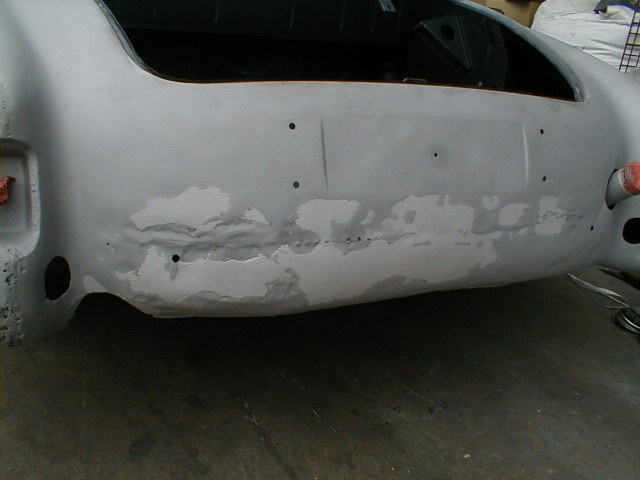
This may have happened during a street race in the seventies. Apparently this car was leading and had better brakes. The light silver patches on the grey steel is lead filler.
After the engine was pulled and the undercarriage repairs were completed we sent the car for media blasting to remove the layers of paint and filler that had accumulated over the years. Due to the soft nature of the aluminum parts (doors, hood & trunk lid) these would be stripped by hand later.
Caution: The following images are of a graphic nature and are intended for mature audiences:
This may have happened during a street race in the seventies.
Apparently this car was leading and had better brakes. The light silver
patches on the grey steel is lead filler.
The blasting removes any trace of plastic filler, aka Bondo (a
trade name).
Now, this is a pretty nice butt-weld which leads me to believe it
was done in Germany circa late fifties, early sixties. It is not factory
though as the fenders came as one unit from the wheel lip to the trunk
weather-seal gutter. No, I think this would explain something I heard
about a ditch and passing a Porsche 356 on the outside of a decreasing radius
turn. I guess the boys got it honestly.
No, those are not machine-gun holes. Body men used to drill
holes to attach a slide hammer to pull dents and creases. Funny thing here
is that they filled it full of holes and still didn't get the crease out.
That's heavy metal for you.
OK, the holes weren't drilled, they were punched.
The brass colored material is........brass.

Notice the line just above the headlight bucket. It is
where a new nose piece was welded on. Trouble is they did a lap-weld where
they should have done a butt-weld. The over lapped area not seam-sealed
collects dirt and moisture and causes the rust damage we see in the next photo.
OK, so a new nose piece was lap-welded in place. Then, it
rusted due to the lap weld. Then the hole was filled with brass.
Then it continued to rust some more. Do you see a pattern here?
We have three elements here - steel, lead and brass. The
plastic is long gone, but that isn't an element anyway.
When we got this car there were some bubbles in the paint in
these areas. So, when you're reading the description of a vintage car on
EBay and it goes something like, " no visible rust, just a few bubbles in the
paint" you've got an idea of what may be underneath.
From the inside.
Now this is nice. That is almost certainly factory lead at
the corner of the hood opening. That is now they got the opening panels to
fit so well. It was all done by hand. No computers, no lasers, no
robots. Just one craftsman working all day for little pay and one beer at
lunchtime (I've heard it was a big beer though).
More factory lead.
The hardtop is pretty much un-scathed.